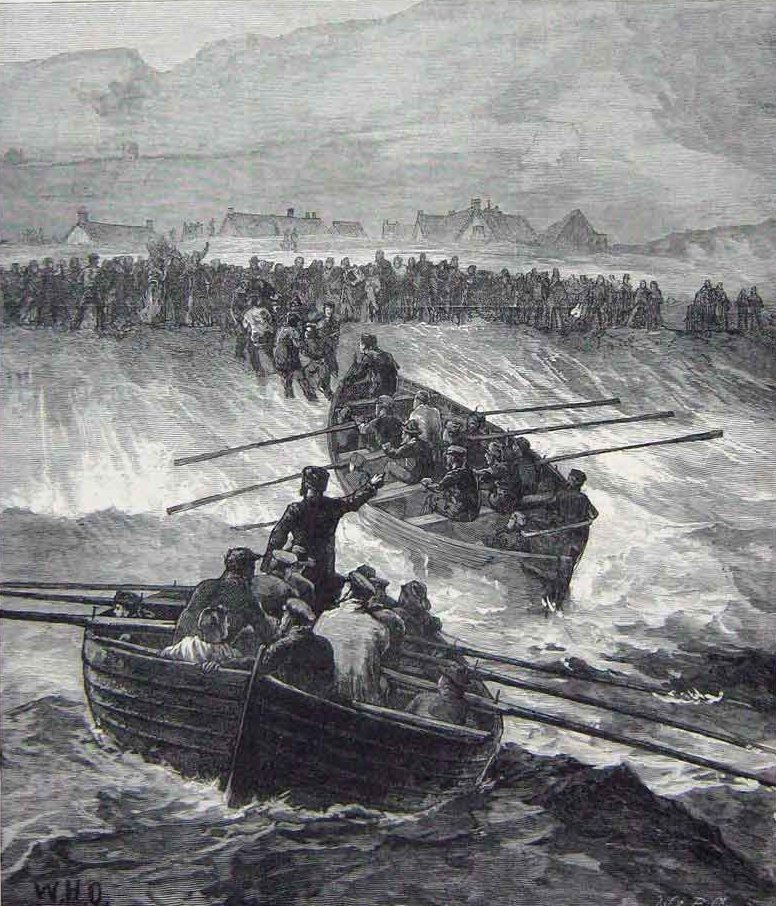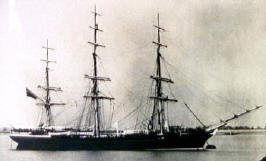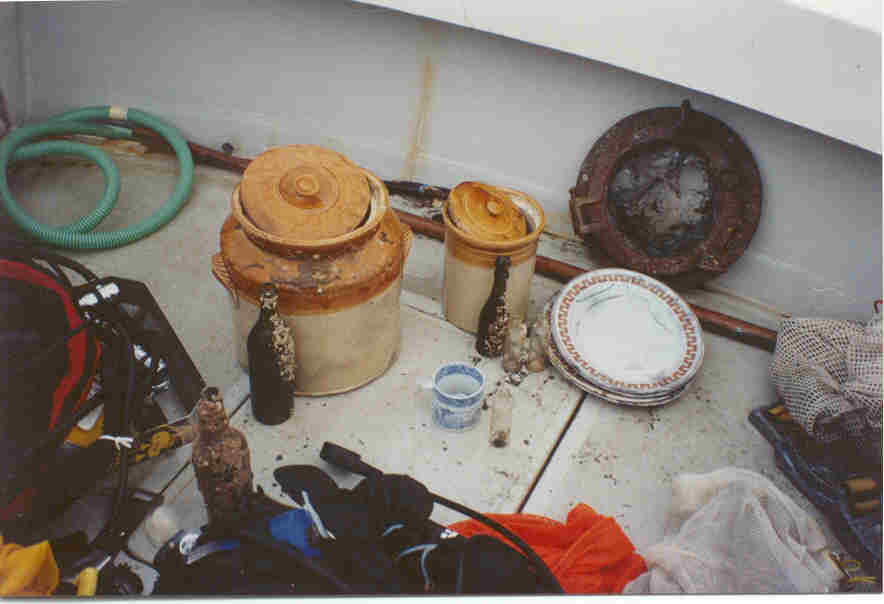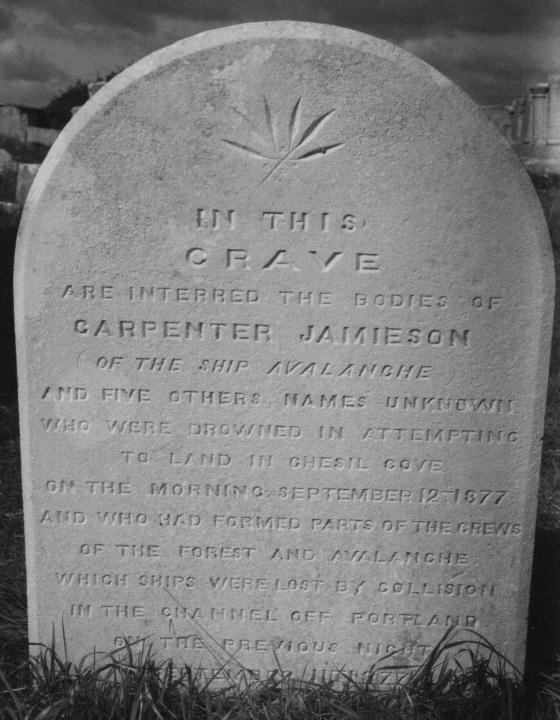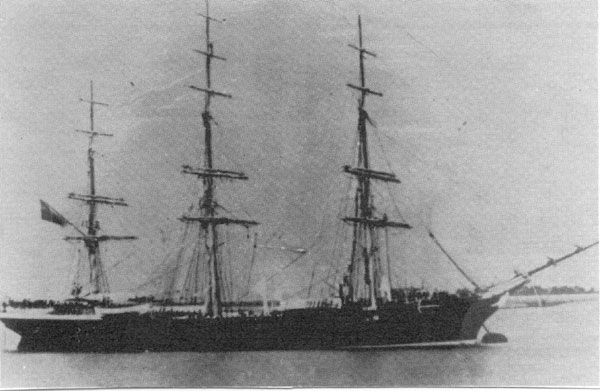
Iron Sailing Ship [50M] – Excellent detail in Dive Dorset: 34 p45 to 47: GPS; 50 26.56N; 02 50.65W. Also in Clarke: (LARN) – 12 miles SW of Portland Bill. Avalanche & Forest, St Andrew’s Memorial Church Pamphlet. See also FOREST. Portland Museum Wreck No. 6. See also Times Reports
Collision in the Channel, Landing the Survivors from the Avalanche & Forest
Illustrated London News – Saturday, September 22nd 1877.
SUMMERY: – The AVALANCHE was an iron three masted sailing vessel of 1210 tons built in Aberdeen. The FOREST was a 1244 ton sailing vessel built in Canada. They collided in a bad storm off Portland on the 11th September 1877 and many of the crew and passengers lost their lives.
The AVALANCHE was outward bound to New Zealand. It had a general cargo of goods from Manchester. Most of its passengers were colonists who were returning after visiting England and emigrants setting out to make new lives for themselves. It had crew of 34. The FOREST was bound for New York and was sailing in ballast, that is without a cargo. It had a crew of 21. Visibility was bad on the night of the collision.
The FOREST hit the AVALANCHE on the port side several times. The AVALANCHE went down in five minutes. All the passengers and most of the crew were lost. The FOREST crew and the three survivors from the AVALANCHE launched three lifeboats. Brave volunteers on Chesil Beach launched two special boats called lerrets and managed to rescue 12 survivors.
A Church was built overlooking the site of the wreck to remember those who died in the tragedy.
Source – Late 18th, 19th and early 20th Century Naval and Naval Social History
The Loss of the Avalanche and the Forest on the night of 11 Sep 1877
On the evening of Tuesday, 11th September 1877, with a south-westerly gale blowing, seas rough and visibility bad, two ships were proceeding down the English Channel to the south-east of Portland and within sight of the Shambles Lightship, Dorset.
The Avalanche saw the red light of another ship close-hauled on the starboard tack and should have given way, but remained on course while the master of the Forest watched the green light until he lost sight of it taking immediate action little knowing that at that moment, the Avalanche also moved off course in a desperate manoeuvre to avoid the collision, but it was too late and placed her broadside across the Forest’s bows which were high in the water and rebounded and continued to strike the iron vessel along her port side and caused overwhelming damage.
The Avalanche sank within a few minutes and only 3 members of her crew managed to leap onto the forecastle of the Forest: 3rd Mate Sherrington, ABs Mills and McCarthy: Ship’s Carpenter Jamieson was picked up later.
The damage to the Forest was also severe and it was soon noted that the pumps were unable to cope with the incoming water and depending on which report one reads within fifteen minutes or within the hour the order was given to abandon ship and 3 boats were launched: one of the boats picked up the Avalanche’s ship’s carpenter.
However, by morning only one boat survived with Captain Lockhart in charge who took the advice of Avalanche survivor AB Mills, a local man, from Bridport, Dorset who advised standing off shore until daylight in the hope that they might be sighted by local fishermen who would then help them to land safely.
The following morning on Portland, Thomas Pitt was beach-combing at dawn, as is the custom for some following a storm, and with the wind still strong and the sea very rough and he found a body and broken boat and sought help from those living nearby in Chiswell, the village which backs onto the Chesil Beach.
John Gibbs and his neighbours searched for survivors but only found five more bodies, but at about 0800 a boat was observed some distance off-shore and fisherman Joe Shaddock called for volunteers to launch a Lerret, a boat especially designed and locally built to suit the unique conditions encountered on the Chesil Beach. When the boat reached the Forest’s boat they found twelve exhausted men aboard and realized they would be unable to land with more than 6 extra men, so signalled for assistance.
A second Lerret soon set off and having overcome the dangers of transferring the survivors to the lerrets they returned to the beach and having overcome the difficult and sometimes dangerous task of landing in a heavy surf, the twelve survivors were taken into local homes, where they were welcomed and given much needed help and comfort.
[On a personal note: having watched one of the last of the Lerrets being rowed out through the surf in order to go fishing and then return later back through the surf in a light sou’ westerly on-shore blow I must admit to being more than impressed by the skill, fitness, strength and timing of the exercise, which at one time would have been carried out several times a day, weather permitting]
The loss of the Avalanche dealt a sad blow to many communities in New Zealand as many of the passengers onboard were returning home.
Avalanche and the Forest 1877
The iron built, 1210 ton, Avalanche, left London bound for Wellington, New Zealand carrying 63 emigrants with a crew of 43 under the command of Captain Ephraim Williams. As she neared Portland Bill, a force eight gale was blowing along with driving rain. The seas were high and sailing was very rough. Sailing nearby was a wooden built ship, the Forest, bound for New York, carrying a crew of 21 men under the command of Captain Lockhart. The two ships were approximately 12 miles off Portland Bill on the stormy night of 11th September 1877. The ships had seen each other but too late to avoid a collision in the bad weather. The Forest struck the middle of the Avalanche, rebounded and struck again almost cutting her in two. The Avalanche sank straight away with the loss of 103 lives, only 3 were saved as they had scrambled onto the Forest. Captain Lockhart on the Forest gave orders to abandon ship using three small boats, but two of those were lost too with the loss of twelve men. The only remaining boat carried the twelve survivors of the two ships to safety, the three who had jumped on the Forest, its Captain and 8 crew. By daybreak, Chesil Beach was once again strewn with wreckage and the local fisherman in lerrets made a chain to rescue those in the boat.
The Forest stayed afloat, though partly submerged near Chesil Cove. It presented a shipping hazard and attempts were made to blow it up. Eventually, it was towed further out 11 days after the tragedy and successfully blown up by the Navy.
Walter Savill of Shaw, Savill and Company who owned the Avalanche, decided that in future, rather then risk any lives around such a treacherous area that most passengers for his vessels would depart from Plymouth.
As the bodies began to be washed ashore by the tide, the responsibility for burial lying with the local parishes, much publicity ensued at the deplorable treatment of the dead. The news hit ‘The Times’ newspaper and there was much uproar caused. The friends and relatives of those lost in the tragedy of the Avalanche launched an appeal fund. Contributions poured in from all over England as well as New Zealand and Australia. Before long, the appeal had raised sufficient funds to purchase a site and erect a memorial chapel overlooking the scene of the disaster. The chapel, sited at Southwell, Portland, was dedicated to St. Andrew and opened in 1879. It is known as Avalanche Church and the road nearby is also named after it.
Evening Post 14th September 1877
The ship Avalanche, Captain Edmund Williams, bound from London to Wellington, came into collision with another vessel in the English Channel. The Avalanche sank immediately. there were lost with the exception of three of the crew. On Tuesday night the Avalanche, when off Portland, was struck amidships by the American ship Forest, Captain Balward sic, and both sank in three minutes.
Evening Post 17th September 1877
Sixty three passengers, chiefly returning colonists, were all drowned. Of the thirty-four seaman, three were saved including the third officer. Of the crew twenty-one on board the Forest nine were saved. The bodies are daily being washed ashore. Among the list are whole families, including eight of the Wilkins’, six of the Lees’, and four of the Chamberlains’.
Messrs Levin and Co. have received the following telegram from Messrs Shaw, Savill and Co.: – “Avalanche run down in the Channel by American ship Forest, and sank instantly. Captain, officers, pilot, crew and passengers drowned.
Convey our deepest sympathy to relatives of passengers. Vogel will wire names. A family named Lee, eight in number, are amongst those lost. We learn that all this family were on board the Avalanche but one-the eldest son – who is in the Government service as as telegraphist at Waitotara (26 miles NW of Wanganui).
“This sad intelligence, which we published in an extra at noon today, caused general consternation in town, as many of our citizens were known to have relations or friends on board the lost ship on their return voyage to Wellington, and a very painful degree of anxiety was felt as to the names of her passengers. These will now be telegraphed by Sir Julius Vogel tomorrow; thus a day of most distressing suspense must be passed till it can be known definitely who was on board. The melancholy fate of the commander of the Avalanche, Captain Williams, will be learned with the feelings of deep sorrow in all parts of New Zealand, especially in Wellington and Canterbury, where he was best known and universally liked and esteemed.
It was only his second trip in the Avalanche, he having brought her out to Wellington last year. His former ship was the Merope, a favourite trader between London and Lyttelton. The chief mate, Mr William Bowling, also was most popular officer and will be much regretted. He is a brother of Captain Bowling, of the Adamant. Of the passengers on board we have been able only to lean that they are supposed to include the wife and family of Mr C. B. Izard (the Crown Prosecutor); A son of Captain Grant, of the Himalaya; A mother and sister of Mr Cooper, an officer on the Queen’s Wharf; The wife and daughter of Mr Justice Richmond; A daughter of Mr W. R. E. Brown, the Registrar-General, Miss W. Watt, daughter of Mr W. H. Watt, Mayor of Wanganui; Mr Robert Barrett intended to return by the Avalanche, but happily changed his mind, and is coming out via Sydney.
Of the ship herself little need be said, the Avalanche being being too well known to require any lengthy details. She was justly esteemed on of the finest ships of Messrs, Shaw, Savill and Co.’s line. She was built at Aberdeen 1874 by Messrs Hall & Sons; she was registered 1161 tons, and was classed 100 A1 She has made three trips to Wellington, two under command of the late Captain H. Bishop, and that of last year under Captain Edmund Williams, the present thus would have been her fourth voyage.
Since the above was written we have learnt with great please that it is almost certain the families of Mr Justice Richmond and Mr Izard did not leave by the Avalanche, but like Mr and Mrs W. H. Levin, who also intended to come by her, postponed their departure until October.
From “Dictionary of Disasters at Sea” by C. Hocking.
Avalanche Shaw, Savill & Co, 1874, A. Hall & Co, 1210 tons, 214.6ft x 36ft x 21.1ft. Launched 29 Aug. 1870.
The iron sailing ship Avalanche left London in Sep. 1877 for Wellington, NZ under Capt. E. S. Williams with 63 passengers and 34 crew. Arrived about 9.30 on the evening of Tuesday, 11th Sep., the ship being in charge of a pilot, she was run down by the sailing ship FOREST, 1,488 tons of Windsor, N. S. in ballast for Sandy Hook, N.Y. The position of the ships at the time was about 15 miles S x W of Portland. John Sherrington, the third mate and two seamen managed to save themselves by leaping aboard the other ship. The impact was of such violence that the Forest was unable to keep the water under control and about an hour after the sinking of the Avalanche, she also foundered. At the time, the sea was very high with violent squalls and three boats were swamped so that, of 24 on board, including the three from the Avalanche, only 12 got ashore. Capt. E. Lockhart and eight of the crew from the Forest were among the survivors, as well as the three men from the Avalanche.
Forest re-floated waterlogged until later sunk with gunpowder by HMS Defence.
Ref. P. Benyon.
Notes:
[1] – The family of Mr Justice Richmond, had endeavoured to secure a passage to New Zealand by the Avalanche, but owing to the berths in that vessel being all taken up, they had to defer their departure from England for a few weeks. Taranaki Herald 18th Sept.
[2] – The South British Insurance cable message states that the company has a full line on the Avalanche. This means either £5,000 or £7,000. She sank in deep water. The losses will be total. Taranaki Herald 25 September 1877. Auckland, Sept. 24.
[3] -A memorial in the churchyard of Papworth Everard reads. “To the Glory of God in Memory of Captain Edmund Williams of the Avalanche who sank with his ship off Portland on the eleventh day of September 1877. This cross is erected by his brother Sydney H Williams”.
[4] – Rugby School Register – Entrance September 1870
Wauton, Frederic William, son of Mrs. Wauton, Rugby, and the late Rev. Joseph Atherton Wauton, aged 13, Aug. 6. Left 1873. Town. Shipwrecked in the Channel in the Avalanche, September, 1877, while on the voyage to New Zealand.
Reference:
The Tragedy of the wrecking of the sailing ships ‘Avalanche’ and ‘Forest’ 11th September 1877. Collated by Friend’s of St Andrew’s Avalanche Memorial Church, Portland.
Are these from the AVALANCHE ? 11/09/1877 – Portland Register.
| 1469 | Six bodies unknown found drowned on Portland Beach | Chesil Beach | 15 Sep 1877 | J A BEAZOR rector |
FOREST : NOTE précis from LARN
The FOREST left London on 09/09/1877 and cast off a tug and the Trinity House pilot off Deal, Kent, the Channel pilot disembarking off the Isle of Wight on the 11th. The master of the FOREST saw green light of the AVALANCHE approaching his vessel and prepared to take avoiding action, but found the other vessel right across his bow and collision could not be avoided. Leaking badly he ordered his ship to be abandoned 15 minutes later by his crew, along with three men who had jumped aboard when they struck, as well as the carpenter w3ho was picked up from the sea. Two of the three boats sank during the night, so that by daylight only that commanded by Captain E. Lockhart was still afloat, he having taken advice of one of the shipwreck survivors who knew the area, to lay off until daylight. The twelve men rescued by the locals who launched a boat. Following this disaster, a church was built and dedicated on Portland to those lost.
Artefacts from the wreck
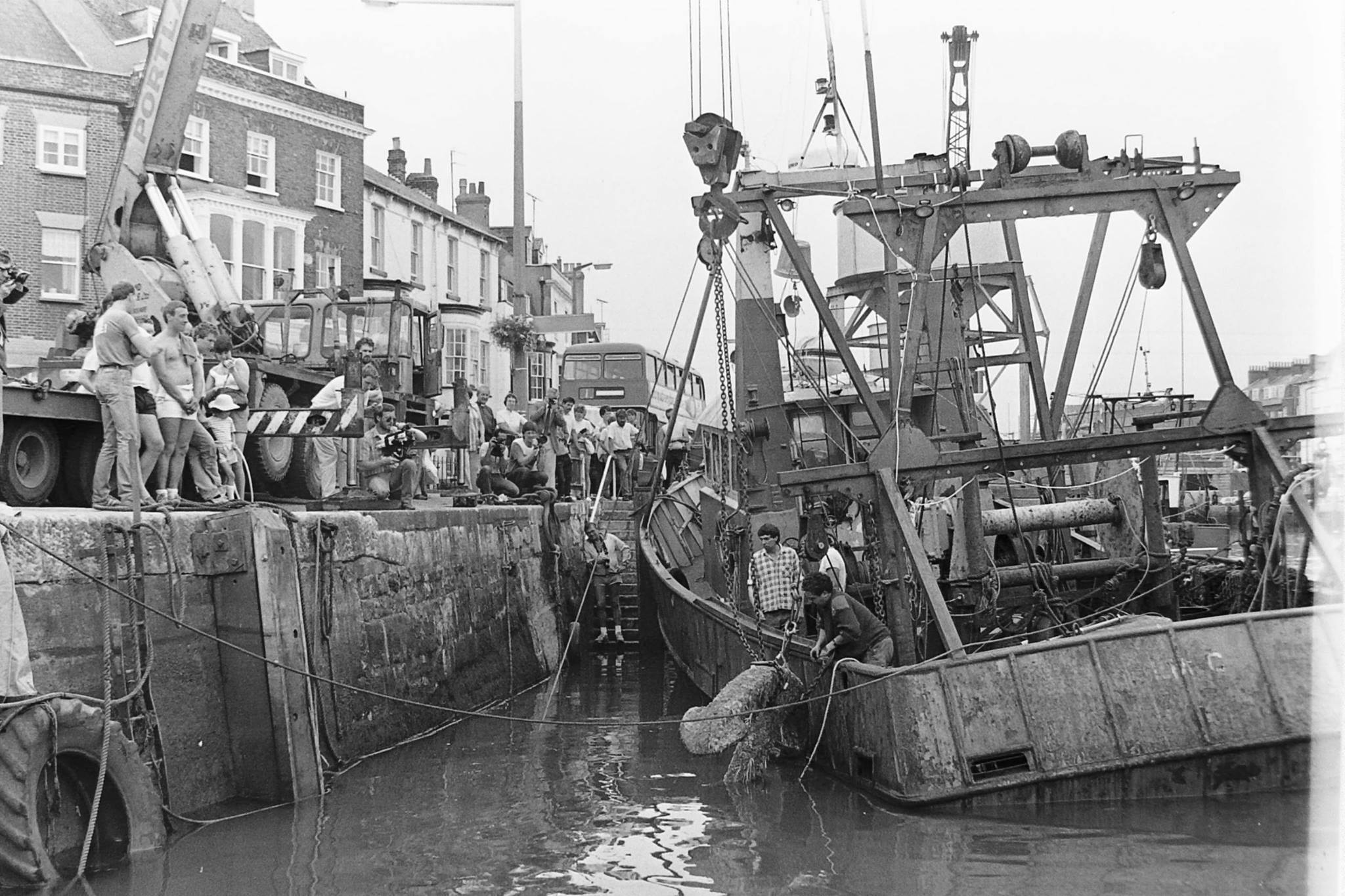
Recovered anchor arriving Weymouth quay
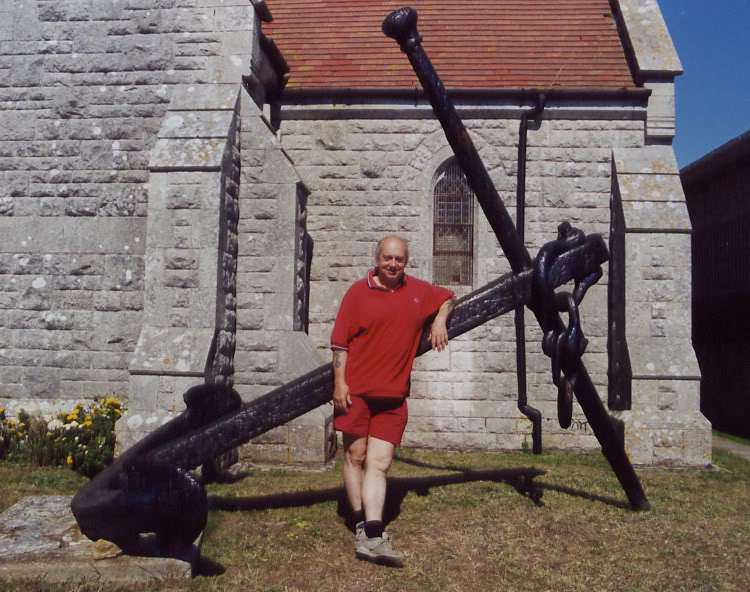
The late Alan Dunster with anchor in place
Day of Loss: 11
Month of Loss: 9
Year of Loss: 1877
Longitude: 50 26.56
Latitude: 02 50.65
Approximate Depth: 50

